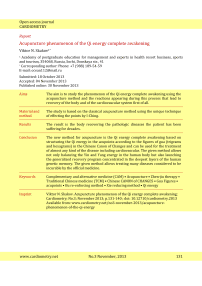Acupuncture phenomenon of the QI energy complete awakening
Автор: Skakov Viktor N.
Журнал: Cardiometry @cardiometry
Рубрика: Report
Статья в выпуске: 3, 2013 года.
Бесплатный доступ
Aims The aim is to study the phenomenon of the Qi energy complete awakening using the acupuncture method and the reactions appearing during this process that lead to recovery of the body and of the cardiovascular system first of all. Materials and methods The study is based on the classical acupuncture method using the unique technique of effecting the points by I-Ching. Results The result is the body recovering the pathologic diseases the patient has been suffering for decades. Conclusion The new method for acupuncture is the Qi energy complete awakening based on structuring the Qi energy in the acupoints according to the figures of gua (trigrams and hexagrams) in the Chinese Canon of Changes and can be used for the treatment of almost any kind of the disease including cardiovascular. The given method allows not only balancing the Yin and Yang energy in the human body but also launching the generalized recovery program concentrated in the deepest layers of the human genetic memory. The given method allows treating many diseases considered to be incurable by the official medicine.
Acupoints, acupuncture, bu re-enforcing method, chinese canon of changes, complementary and alternative medicine, gua figures, qi energy, traditional chinese medicine, xie reducing method, zhen-jiu therapy
Короткий адрес: https://sciup.org/148308750
ID: 148308750
Список литературы Acupuncture phenomenon of the QI energy complete awakening
- McQuade JL, Meng Z, Chen Z. Utilization of and Attitudes towards Traditional Chinese Medicine Therapies in a Chinese Cancer Hospital: A Survey of Patients and Physicians. EVIDENCE-BASED COMPLEMENTARY AND ALTERNATIVE MEDICINE. 2012 DOI: 10.1155/2012/504507
- Pippa L, Manzoli L, Corti I, et al. Functional capacity after traditional Chinese medicine (qi gong) training in patients with chronic atrial fibrillation: a randomized controlled trial. Preventive cardiology. 2007;10(1):22-5 DOI: 10.1111/j.1520-037X.2007.05721.x
- Falev AI. Classical Chinese Zhen-jiu therapy [in Russian]. Moscow Olympia 1999.
- Falev AI. Issues of alternative medicine. Vol 1,Sochi-Voronezh2003.
- Acupuncture and Moxibustion. Shanghai: Shanghai Science and Technology Publishing House; 1979.
- Sanchez VJ. Qi Gong: medicine or enlightenment? Revista de enfermeria (Barcelona, Spain) 2005-May;28(5):40-4.
- Zauner-Dungl A. Is Qi Gong suitable for the prevention of low back pain? Wiener medizinische Wochenschrift. 2004-Dec;154(23-24):564-7 DOI: 10.1007/s10354-004-0126-4
- Essentials of Chinese Acupuncture. Beijing: People’s Medical Publishing House; 1979.
- McKee MD, Kligler B, Fletcher J, et al. Outcomes of acupuncture for chronic pain in urban primary care. Journal of the American Board of Family Medicine: JABFM. 2013 Nov-Dec;26(6):692-700 DOI: 10.3122/jabfm.2013.06.130003
- Carruzzo P, Graz B, Rodondi P-Y, et al. Offer and use of complementary and alternative medicine in hospitals of the French-speaking part of Switzerland. SWISS MEDICAL WEEKLY SEP 6 2013;143 DOI: 10.4414/smw.2013.13756
- Vinjamury SP, Li J-T, Hsiao E, et al. Effects of acupuncture for cancer pain and quality of life -a case series. CHINESE MEDICINE 2001;8 DOI: 10.1186/1749-8546-8-15
- Kanodia AK, Legedza ATR, Davis RB, et al. Perceived Benefit of Complementary and Alternative Medicine (CAM) for Back Pain: A National Survey. JOURNAL OF THE AMERICAN BOARD OF FAMILY MEDICINE. MAY-JUN 2010;23(3):354 DOI: 10.3122/jabfm.2010.03.080252


